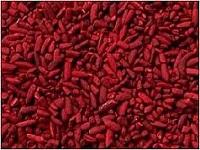  | Red yeast rice (simplified Chinese: 红曲米; traditional Chinese: 紅麴米); pinyin: hóng qū mǐ; literally "red yeast rice"), red rice koji (べにこうじ, lit. 'red koji') or akakoji (あかこぎ, also meaning 'red koji'), red fermented rice, red kojic rice, red koji rice, anka, or ang-kak (Hokkien Chinese borrowed from Tagalog), is a bright reddish purple fermented rice, which acquires its colour from being cultivated with the mold Monascus purpureus.
Red yeast rice is what is referred to, in Japanese, as a koji, meaning 'grain or bean overgrown with a mold culture', a food preparation tradition going back to ca. 300 BC.In both the scientific and popular literature in English that draws principally on Japanese, it is most often known as "red rice koji". English works favoring Chinese sources may prefer the translation "red yeast rice".
Due to the low cost of chemical dyes, some producers of red yeast rice have tried to modify their products with red dye #2 Sudan Red G.
Culinary
Red yeast rice is used to colour a wide variety of food products, including pickled tofu, red rice vinegar, char siu, Peking Duck, and Chinese pastries that require red food colouring. It is also traditionally used in the production of several types of Chinese wine, Japanese sake (akaisake), and Korean rice wine (hongju), imparting a reddish colour to these wines. Although used mainly for its colour in cuisine, red yeast rice imparts a subtle but pleasant taste to food and is commonly used in the cuisine of Fujian regions of China.
Traditional Chinese medicine
In addition to its culinary use, red yeast rice is also used in Chinese herbology and traditional Chinese medicine. Its use has been documented as far back as the Tang Dynasty in China in 800 AD. It is taken internally to invigorate the body, aid in digestion, and revitalize the blood. A more complete description is in the traditional Chinese pharmacopoeia, Ben Cao Gang Mu-Dan Shi Bu Yi, from the Ming Dynasty (1378–1644).
|